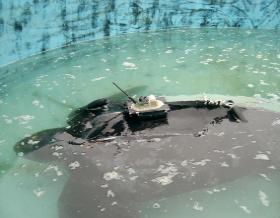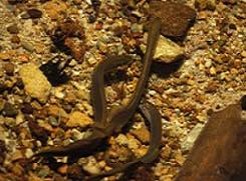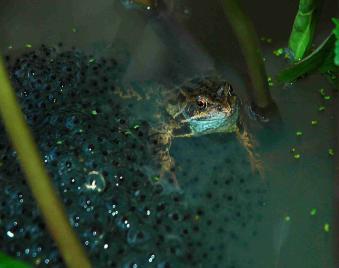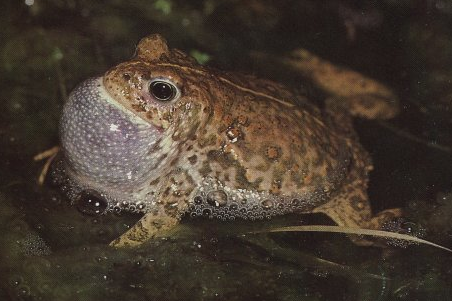National Frog Survey of Ireland
| Amphibians (frogs, toads and newts) are one of the most threatened groups of organisms on earth, with a third of all species having suffered declines. Ireland has only one species of frog (Rana temporaria) which is a key part of Irish ecosystems as a predator of insects and other invertebrates, as well as itself being prey for other species. |
Adult frog (Rana temporaria) with spawn (Photo: Fred Holmes, ARC) |
The National Frog Survey of Ireland began in March 2010 and will run until November 2011. As well as producing an up to date map of frog distribution in Ireland, the survey will also examine the aquatic and terrestrial habitats used by frogs and gather information on the threats facing these habitats. Baseline data on the size of the national frog population will also be gathered against which future population changes can be compared. The survey is funded by the Department of the Environment, Heritage and Local Government and will be carried out by National Parks and Wildlife Service Conservation Rangers in partnership with Giorria Environmental Services, Quercus at Queen’s University Belfast and the charity Amphibian and Reptile Conservation.
The results of the survey will help fulfil obligations under the EU Habitats Directive and, ultimately, will help to ensure the long-term survival of frogs in Ireland.
Other Research Projects
Natterjack Toad
|
From April to July 2016-2018, spawning activity will be recorded every 7-14 days at all breeding sites and at the 100 breeding ponds newly dug under the Toad Pond Creation Scheme. Egg strings, tadpoles and juvenile numbers will be monitored and from this the total size of the breeding population can be estimated. The information collected will update the last monitoring report by Sweeney et al. (2013) and contribute to the next Article 17 report on the conservation status of the species under the EU Habitats Directive, due in 2019. The three year project (starting December 2015), will be run by Dr Neil Reid and Prof Mark Emmerson at Queen’s University Belfast, and is funded by the National Parks & Wildlife Service of the Department of Arts, Heritage and the Gaeltacht. |
|
Monitoring the toad's breeding success will provide sufficient data to determine trends in population growth and to provide a baseline against which to compare future surveys. This will also enable research to take into consideration annual variability when investigating the effect of environmental factors on the toad breeding activity. Meanwhile the implementation of the strategies identified in the conservation plan for the Natterjack Toad (Irish Wildlife Manual No 10: ![]() [493KB]) continues. Most recently NPWS has launched a scheme to encourage farmers to dig new ponds for toads. Around Castlemaine and West of Castlegregory, farmers will be paid €500 per pond per year. You can read more about the NPWS toad scheme here.
[493KB]) continues. Most recently NPWS has launched a scheme to encourage farmers to dig new ponds for toads. Around Castlemaine and West of Castlegregory, farmers will be paid €500 per pond per year. You can read more about the NPWS toad scheme here.
Leatherback Turtles in Irish Waters
Research into leatherback turtles (Dermochelys coriacea) has taken great strides in recent years and NPWS were very pleased to have been able to provide funding towards the satellite tracking work being carried out by UCC. A report on the migration behaviour of leatherbacks in Irish waters can be downloaded here (Irish Wildlife Manual No 32: ![]() [10,518KB]). Two animals were tagged off Dingle, in Co. Kerry, a female in 2005 and a male in 2006. The subsequent migration, diving and feeding behaviour of these animals was then followed for several months. Both animals headed South for the Cape Verde Islands. The female then turned north-west and was last seen heading for Newfoundland; the male was last seen off the coast of French Guyana, the area where the Irish turtles are thought to breed. More details on the leatherback turtle project are available on the link provided. NPWS also providing some funds in 2007 / 2008 and again in 2008 / 2009 to increase patrols along leatherback nesting beaches in the Gabon - the most important leatherback turtle nesting beaches in the Atlantic. Read about Turtle Protection in Gabon, 2007 - 08
[10,518KB]). Two animals were tagged off Dingle, in Co. Kerry, a female in 2005 and a male in 2006. The subsequent migration, diving and feeding behaviour of these animals was then followed for several months. Both animals headed South for the Cape Verde Islands. The female then turned north-west and was last seen heading for Newfoundland; the male was last seen off the coast of French Guyana, the area where the Irish turtles are thought to breed. More details on the leatherback turtle project are available on the link provided. NPWS also providing some funds in 2007 / 2008 and again in 2008 / 2009 to increase patrols along leatherback nesting beaches in the Gabon - the most important leatherback turtle nesting beaches in the Atlantic. Read about Turtle Protection in Gabon, 2007 - 08 ![]() [5.3MB].
[5.3MB].

Leatherback turtle (Dermochelys coriacea) with tracking device
The distribution and status of lampreys in Ireland
Three species of lamprey (brook lamprey Lampetra planeri, river lamprey L. fluviatilis and sea lamprey Petromyzon marinus) occur in Ireland. All three are listed on Annex II of the Habitats Directive. NPWS has funded a survey programme to map the distribution and abundance of these lampreys in the main SACs designated for their protection.
Detailed surveys have taken place on the Slaney (Irish Wildlife Manual No 14: ![]() [1,095KB]), Blackwater (Irish Wildlife Manual No 14:
[1,095KB]), Blackwater (Irish Wildlife Manual No 14: ![]() [1,095KB]), Moy (Irish Wildlife Manual No 15:
[1,095KB]), Moy (Irish Wildlife Manual No 15: ![]() [2,937KB]), Feale (Irish Wildlife Manual No 22:
[2,937KB]), Feale (Irish Wildlife Manual No 22: ![]() [1,007KB]), Barrow (Irish Wildlife Manual No 21:
[1,007KB]), Barrow (Irish Wildlife Manual No 21: ![]() [665KB]), Boyne (Irish Wildlife Manual No 24:
[665KB]), Boyne (Irish Wildlife Manual No 24: ![]() [1,122KB]), Suir and Corrib (Irish Wildlife Manual No 26:
[1,122KB]), Suir and Corrib (Irish Wildlife Manual No 26: ![]() [1,114KB]).
[1,114KB]).
While most of the data relates to juveniles, information on spawning has also been collected. Data has been compiled for eight additional catchments as part of a project to develop a lamprey monitoring protocol. Our results show significant differences in lamprey densities both within and between catchments. Dredging and weirs are two of the biggest threats to the favourable conservation status of these animals.

Brook Lamprey (Lampetra planeri) (Photo: Eddie Dunne)
Members of the Scientific Unit can be contacted by e-mailing: natureconservation@npws.gov.ie


 Ireland has just three species of native amphibians and the Natterjack toad (Bufo calamita) is the rarest, restricted to Co. Kerry. A new three year project to study the toad at its breeding sites in Kerry has just commenced. This project will focus on updating our understanding of toad distribution, evaluate breeding success and estimate adult population sizes and trends. It will also examine aquatic and terrestrial habitat quality and assess the success of the ongoing pond creation scheme.
Ireland has just three species of native amphibians and the Natterjack toad (Bufo calamita) is the rarest, restricted to Co. Kerry. A new three year project to study the toad at its breeding sites in Kerry has just commenced. This project will focus on updating our understanding of toad distribution, evaluate breeding success and estimate adult population sizes and trends. It will also examine aquatic and terrestrial habitat quality and assess the success of the ongoing pond creation scheme.